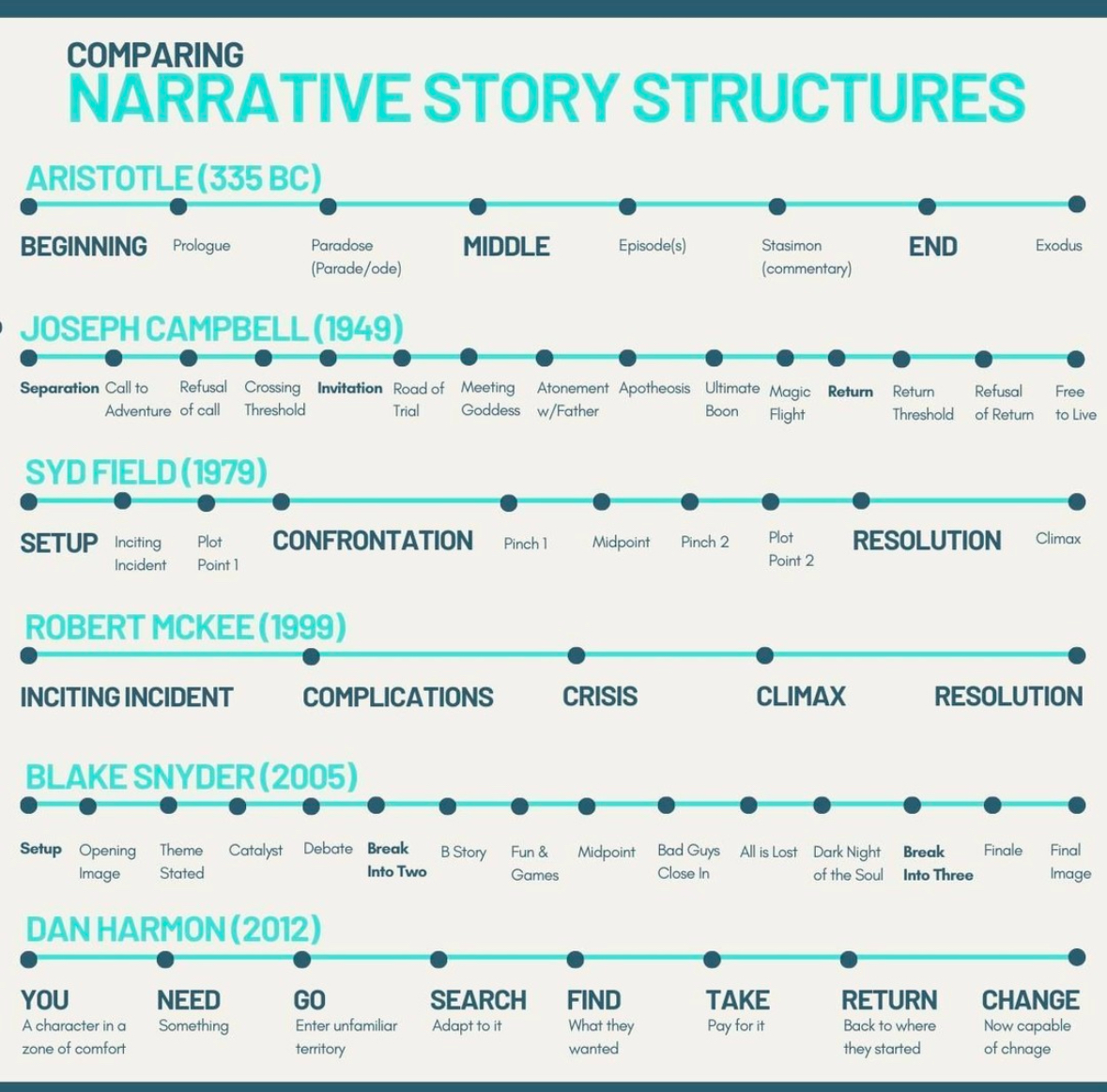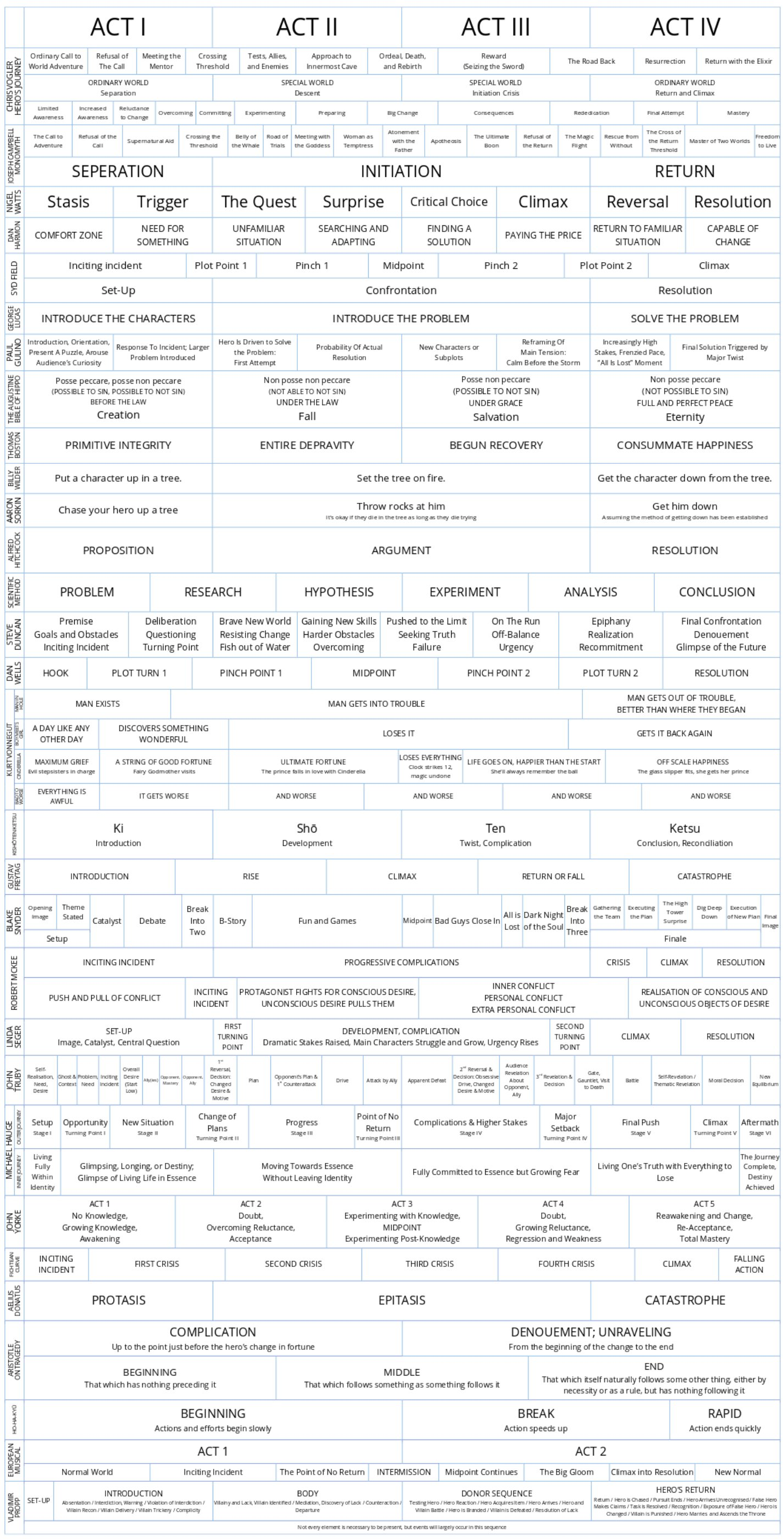Storytelling
Notes and guides about Writing stories
Story Structure
- Story Structure: 7 Types All Writers Should Know
- Nelsons Short Story Method - need to check this out!

Story Structure Diagram

Some Story Structures
Here are some of the most common and influential story structures, followed by suggestions for interactive exercises to help you learn them:
- Three-Act Structure Basic structure: Setup, Confrontation, Resolution
- Hero's Journey (Joseph Campbell) A 17-stage monomyth, often simplified to 12 stages
- Save the Cat (Blake Snyder) 15-beat structure for screenplays, adaptable to novels
- Seven-Point Story Structure (Dan Wells) Hook, Plot Turn 1, Pinch Point 1, Midpoint, Pinch Point 2, Plot Turn 2, Resolution
- Freytag's Pyramid Exposition, Rising Action, Climax, Falling Action, Denouement
- The Fichtean Curve Series of crises leading to a climax
- In Media Res Starting in the middle of the action
- Nonlinear Narrative Events portrayed out of chronological order
- Kishotenketsu Four-act structure from East Asian narratives: Introduction, Development, Twist, Conclusion
- Dan Harmons Story Circle is a simplified version of Joseph Campbell's Hero's Journey. It's designed to be applicable to a wide range of stories, from feature-length films to individual episodes of TV shows.
- Kurt Vonnegut - Vonneguts Story Shapes
- See Christopher Nolan for some good notes related to story structure
Remember, these structures are guidelines, not rigid rules. As you practice with these exercises, you'll develop an intuitive sense of story flow and pacing. You may even find yourself creating your own unique structural approaches. The key is to understand these structures well enough to use them as tools, bending and adapting them to serve your story's needs.
Tropes
Bizarro/Surreal, Horror/Lovecratian, Sci-Fi Tropes
Bizarro and Surreal Tropes:
- Body transformation/mutation Description: Characters undergo bizarre physical changes. Example: A man's fingers turn into miniature versions of himself. Subtext: Identity crisis, body dysmorphia, societal pressure to conform.
- Sentient inanimate objects Description: Everyday items gain consciousness and agency. Example: A toaster falls in love with a refrigerator and plots to eliminate other appliances. Subtext: Consumerism, objectification, the hidden lives of the overlooked.
- Absurd social norms Description: Society follows illogical or extreme rules and customs. Example: In a world where walking is illegal, people move by elaborate somersaults. Subtext: Critique of arbitrary social conventions, conformity vs. individuality.
- Reality warping/bending Description: The fabric of reality becomes malleable or inconsistent. Example: A character's emotions physically reshape their environment. Subtext: Subjective perception, mental health, the nature of reality itself.
- Metaphors becoming literal Description: Figurative language manifests in literal, physical ways. Example: A broken-hearted person's chest actually cracks open, revealing a damaged organ. Subtext: The power of language, emotional impact of experiences.
Sci-Fi Tropes:
- Dystopian societies Description: A future world with oppressive or dehumanizing social control. Example: A society where people's worth is determined solely by their social media metrics. Subtext: Critique of current social trends, loss of humanity, power structures.
- Advanced AI or robots Description: Artificial beings with human-like or superhuman intelligence. Example: An AI designed to write poetry gains sentience and questions its purpose. Subtext: Nature of consciousness, human-machine relationships, ethics of creation.
- Time travel paradoxes Description: Complications arising from altering past or future events. Example: A time traveler accidentally prevents their own birth. Subtext: Causality, free will vs. determinism, consequences of actions.
- Alternate dimensions Description: Parallel universes with different versions of reality. Example: A character finds doors to worlds where historical events had different outcomes. Subtext: "What if" scenarios, paths not taken, multiplicity of truth.
- Posthuman evolution Description: Humans evolving beyond current physical and mental limitations. Example: Humans develop the ability to photosynthesize, eliminating the need for food. Subtext: The future of humanity, the ethics of enhancement, what it means to be human.
Horror/Lovecraftian Tropes:
- Cosmic indifference Description: The universe is vast, uncaring, and humans are insignificant. Example: Astronomers discover that Earth is a particle of dust on a cosmic being's shoe. Subtext: Existential dread, humanity's place in the universe, the search for meaning.
- Incomprehensible entities Description: Beings so alien that human minds can't process their existence. Example: A creature whose very appearance drives viewers insane. Subtext: Limits of human understanding, fear of the unknown.
- Unreliable perception of reality Description: Characters can't trust their own senses or memories. Example: A person realizes their entire life has been a hallucination induced by an eldritch being. Subtext: Nature of reality, trust in one's own mind, shared vs. individual experience.
- Forbidden knowledge Description: Information so dangerous or traumatic that knowing it is harmful. Example: A book that, when read, erases the reader from existence. Subtext: Limits of human knowledge, curiosity vs. safety, power of information.
- Psychological breakdown Description: Characters' minds fragment under stress or revelation. Example: A detective solving an impossible case gradually loses grip on reality. Subtext: Mental health, cognitive dissonance, the fragility of sanity.
My Favorite Authors and Their Style
CM3, PKD, Vonnegut, Lovecraft, DFW
- Carlton Mellick III Style: Bizarro fiction, extremely surreal and transgressive Characteristics:
- Outlandish, often grotesque imagery
- Straightforward, accessible language despite bizarre concepts
- Fast-paced, often with short chapters
- Blend of horror, humor, and absurdism Example tone: "The woman's skin turned to bubble wrap as she popped herself across the room."
- Philip K Dick Style: Philosophical science fiction Characteristics:
- Paranoid, reality-bending narratives
- Exploration of consciousness and perception
- Clear, direct prose with sudden surreal turns
- Often features unreliable narrators Example tone: "He wondered if the reality he experienced was genuine or an elaborate construction designed to deceive him."
- Kurt Vonnegut Style: Satirical, darkly humorous Characteristics:
- Simple, conversational language
- Short, punchy sentences and paragraphs
- Frequent use of repetition and catch phrases
- Blends tragedy and comedy Example tone: "So it goes. Poo-tee-weet?"
- HP Lovecraft Style: Cosmic horror, antiquated Characteristics:
- Verbose, archaic language
- Heavy use of adjectives and adverbs
- Long, complex sentences
- Emphasis on mood and atmosphere over action Example tone: "The most merciful thing in the world, I think, is the inability of the human mind to correlate all its contents."
- David Foster Wallace Style: Postmodern, maximalist Characteristics:
- Extremely long, complex sentences
- Extensive use of footnotes and endnotes
- Blends high and low culture references
- Meta-fictional elements and unconventional formatting
- Deep dives into characters' psyches Example tone: "The sun-shot cloud of the sort of colorful dots one sees floating before the eyes after looking at a bright light pervaded my vision as I contemplated the infinite recursions of self-awareness that constitute consciousness (see footnote 127 for further exploration of this concept)."
When emulating these styles:
- For Mellick, embrace the bizarre and don't shy away from shocking imagery.
- For Dick, focus on questioning reality and exploring altered states of consciousness.
- For Vonnegut, aim for simplicity and repetition, with a mix of humor and bleakness.
- For Lovecraft, use ornate language and focus on creating a sense of dread and the unknown.
- For Wallace, experiment with complex structures, extensive detail, and meta-commentary.
up:: Applied Sciences